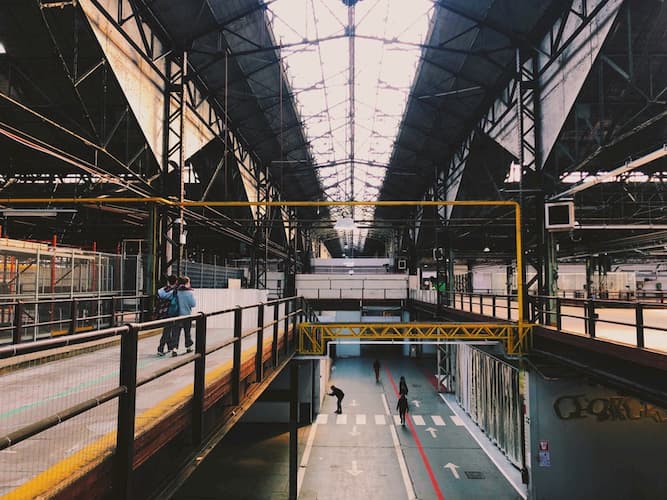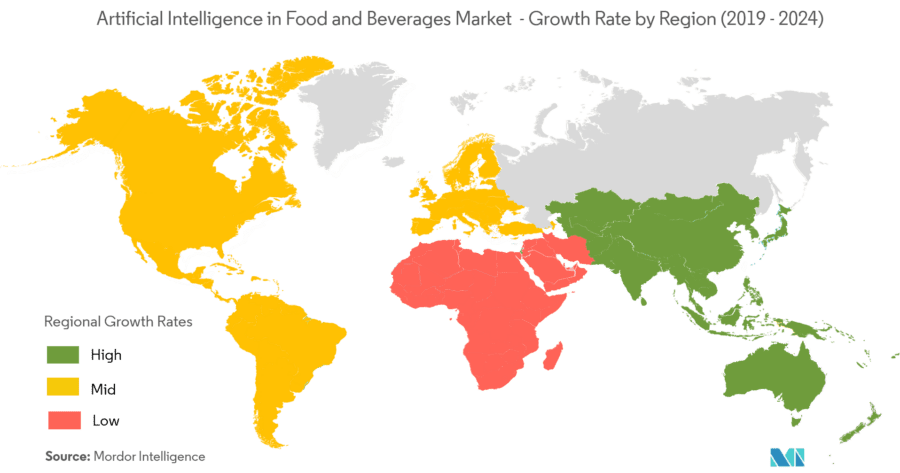Artificial Intelligence and Machine Learning solutions offer large possibilities to optimize and automate processes, save costs and make less human error possible for many industries. Food and Beverage is not an exception, where it can be beneficially applied in restaurants, bar and cafe businesses as well as in food manufacturing. These two segments have common use cases where AI in the food industry can be applied, as well as different ones, which is linked to different problems that must be solved.

Contents of this article
1 Start from food market analysis
2 Cleaning equipment that does not need disassembling (CIP)
3 Better hygiene – KanKan AI in the Food and Beverage industry solution.
4 Food and beverage supply chain optimization
5 Using AI in Food Industry: Machine Learning applications in Food Manufacturing
- 5.1 Supply chain optimization – less waste and more transparency
- 5.2 Sorting food: optical sorting solutions
- 5.3 Predictive maintenance, remote monitoring and condition monitoring
6 Machine learning applications in the restaurant business
- 6.1 Analytical solutions for a better customer experience
- 6.2 Food-selling site and applications
- 6.3 AIs for online restaurant search
- 6.4 Voice searches
- 6.5 Self-serving system
- 6.6 Innovations in robotics for the food industry
7 Artificial Intelligence in Food Waste
8 Future Application of AI in Food
9 AI in Food and Beverage Statistics
10 Benefits of AI in Food
11 Conclusion
- 11.1 Share:
- 11.2 Related Insights
1. Start from food market analysis
Knowing what goods to manufacture in large amounts or what dishes are the best choice to include in your restaurant menu is the key to increase earnings. Often customers’ and market demands are changing very fast and so it is even more important to be one step ahead to take measures in time. Defining the most widespread tastes and preferences is the most valuable thing for a food business owner as well as for a food manufacturer. For example, the newest trends in food tech are linked to a stream of healthy lifestyle followers. In order to detect them, Machine learning uses Data Collection and Classification methods and deduces which food tech solutions related trends are going to be on top very soon. A similar solution is given by Castrograph AI – it predicts flavors and preferences of customers at the pre-production stage, saving funds for future Food tech and Beverage businesses that will avoid spending money on low-required production. AI for food understands human perception of flavor and preferences, dividing users into different demographic groups and modeling their preference behavior or predicting what they want even before they do.
Cleaning equipment that does not need disassembling (CIP)
Both, manufacturing of large productions of goods or big restaurants need expensive and complicated machines to clean and process many foods every day. So, significant amounts of substances of a different kind go through the cleaning equipment and, as long as it is very costly to disassemble it every time, there must be a better decision. Such equipment demands a lot of time and resources, like water. Developers from the University of Nottingham have developed a system able to economize resources by 20-40%.
This system is called SOCIP, or Self-Optimizing-Clean-In-Place and it uses ultrasonic sensing and optical fluorescence imaging to assess food remains and microbial debris inside the equipment for food processing. But there is one disadvantage to this system – it is operated blind and so it is built for the worst-case scenario, tending to result in overcleaning. Still, the system will allegedly save around 100 million pounds for the country (UK).
Better hygiene – KanKan AI in the Food and Beverage industry solution.
Every food factory needs to make sure that their workers keep hands and things clean, as it is the factor number one to influence food safety. Also, it is very important to monitor if the cooking crew keeps everything nice and clean in the restaurant kitchen. Surveillance systems, able to detect and track people, their movements and attire items are able to cope with this task. There are such solutions as KanKan AI can be used by food tech companies in manufacturing, or in restaurants and cafes. The embedded camera monitors workers by recognizing their faces meanwhile detecting if they are wearing masks or hats as demanded by the food safety law. This technology is estimated at around 95% accuracy, detects violations and turns them into images.
Food and beverage supply chain optimization
Algorithms based on Artificial Neural Networks can monitor and check the process of AI food delivery and goods tracking at every step, making it safer and providing transparency. Also, it makes forecasts as to pricing and inventory, which preserves extra costs.
Now let’s see how applicable machine learning can be in the manufacturing and restaurant business in different cases.
 https://spd.group/wp-content/uploads/2019/04/photo-1554070211-e3953… 300w” sizes=”(max-width: 667px) 100vw, 667px” />
https://spd.group/wp-content/uploads/2019/04/photo-1554070211-e3953… 300w” sizes=”(max-width: 667px) 100vw, 667px” />
Using AI in Food Industry: Machine Learning applications in Food Manufacturing
Supply chain optimization – less waste and more transparency
As long as food manufacturers are concerned with food safety regulations that have become more firm, they need to appear more transparent about the path of food in the supply chain. Here AI in food manufacturing helps to monitor every stage of this process: it makes predictions as to the price and inventory management and tracks the path of goods from where they are grown and, eventually, to the place where consumers get it, ensuring the transparency. A solution such as Symphony Retail AI enables us to estimate the demands for transportations, pricing and inventory not to get an abundance of goods that can turn into waste as a result.
Sorting food: optical sorting solutions
Previously, a manufacturer had to hire many people for performing monotonous and routine actions linked to food selection. Now, instead of manually sorting large food amounts by size and shape, so that it can be canned or bagged, you can use AI-based solutions to easily recognize which plants should be potato chips and which are better to use for French fries. Vegetables of an inappropriate color will also be sorted out by the same system, decreasing the chance that they are discarded by buyers. Food Sorters and Peelers developed by TORMA show better processing capacity and availability, which gives food more quality and safety. This is achieved by using core sensor technologies and camera that recognizes material based on color, biological characteristics, and shape(length, width, diameter), these cameras have an adaptive spectrum that is the best suit for optical food sorting.
Predictive maintenance, remote monitoring and condition monitoring
It is obvious that manufacturing a lot of goods demands big, complicated and intricately constructed mechanisms. The maintenance of such machines can be rather costly without predictive maintenance – figuring out the time-to-repair and cost-to-repair indicators through categorizing issues and making predictive alerts. Timely repairs can save up to 50% maintenance time and reduce the costs needed for it to almost 10%. To perform remote monitoring on complicated mechanisms you can make a Digital Twin of a machine that will show you the performance data on parameters and manufacturing processes and boost the throughput. Machine learning also allows identifying factors affecting the quality and causing flows in the manufacturing process with Root Cause Analysis (eliminating the problem in its very source). With condition monitoring, you are able to monitor the equipment’s health in real-time to reach high overall equipment effectiveness (OEE).
Machine learning applications in the restaurant business
Analytical solutions for a better customer experience
Currently, there are several applications in the foodservice space that may help to foresee visitor traffic on different seasons and events, food orders and relevant inventory needs to predict the number of orders for a certain period/date. Such applications and solutions collect previous data to engage customers more through examining their habits and preferences: it brings more repeat visits and orders in the result. These are Cloud Big Data solutions, restaurant management platforms to make the paying process easier, applications that allow connecting and pre-order a table in advance.
Food-selling site and applications
Once you have defined what to produce, the next step is to make the best online service system for your Food Beverage business for people who discovered your existence through the Internet or decided to examine your menu/order takeaway online. Say, it will be an online site that gives the best recommendations/makes the order process really quick or a mobile application with a convenient and smart AI foods system. E-commerce is getting more popular in the digital world so it is a bad thing to forget the promotion of your goods on the Internet. Automated customer service and customer segmentation can significantly increase the accuracy and efficiency of administrative functions such as creating reports, placing orders, dispatching crews, formulating new tasks and etc.
AIs for online restaurant search
Restaurants, cafes, and bars are also dependent on their ratings and feedback on the Internet. Nowadays many customers get to know about their existence through Google maps/searches. In these cases, an AI in foodservice solution offers to unite the data from various food delivery programs to give the user a hint for a café or a restaurant that might appeal to his tastes and be relevant to the location. There are also AI agents that notify clients about any sales and events in their favorite restaurants via their most used platforms like Twitter or Slack.
Voice searches
As people begin to prefer voice search over typing anything into the Google address (around 27% of the population), voice commerce seems to gain more significance. Restaurants can create tools such as Amazon Alexa to allow their customers to make an immediate order without even an ordinary “click”. In such a way you can place orders quickly and hands-free.
Self-serving system
Self-serving (point-of-sell systems) are being massively taken up by restaurants as long as they enable customers to control the ordering process, carefully examining their choice, sometimes even checking the number of flavors and spices put into the dish. It is believed that this technology should be available for all size restaurant businesses, not only for big ones. Applications and terminals allowing to make a self-order reduce customer wait time, make orders more accurate and increases customer experience, being highly engaging.
Innovations in robotics for the food industry
Some of the most complicated and brightest AI-based solutions like robotics have popped up recently, but are only a privilege for big food businesses and fabrics, still unavailable for small-to-medium. These are drones to deliver orders or robotic hands that can manage many processes in food manufacturing and even cooking. However, these devices can get popular due to the exponential rise of human talent wages and can save more costs in a long-term run. The International chain of convenience stores 7-Eleven already uses drones and street boots in its delivery service while Walmart claims that it will soon use drones in warehouses. Another curious robotics implementation is the “Flippy” robot which actually consists of two mechanical hands, able to take and turn over fried burger patties and put them into buns along with other ingredients for burgers.
Artificial Intelligence in Food Waste
The United States Department of Agriculture claims that: “In the United States, food waste is estimated at between 30-40 percent of the food supply. This estimate, based on estimates from USDA’s Economic Research Service of 31 percent food loss at the retail and consumer levels, corresponded to approximately 133 billion pounds and $161 billion worth of food in 2010. This amount of waste has far-reaching impacts on society.”
The Source https://www.usda.gov/foodwaste/faqs
According to McKinsey Artificial Intelligence can solve this problem and unlock a $127 billion opportunity by reducing food waste in 2030! Such astonishing numbers could be achieved by introducing more regenerative recreational agricultural practices. What does that mean? It means that humans currently don’t use their resources wisely and mono-cropping, the blanket application of synthetic chemical fertilizers and intensive land use can be replaced with “smarter” methods. Information gathered from sensors, drones, and satellites, as well as other equipment, could help farmers to make better decisions faster. Here are some ways to reduce food waste with AI:
- While some solutions analyze the ripeness of the fruits, another figure out what microbes could increase crop growth without the involvement of synthetic fertilizers.
- Farmers could get rid of field trials, benefiting from advantages of the AI, which will significantly save money.
- If farm-based food supply chains will use visual imagery technology, the food inspection process will be much easier.
- AI food tracking will enable us to sell food before it becomes a waste, connecting farmers with restaurants or people buying food more efficient.
The main challenge, to make these ideas a reality can’t be delivered by one company. The whole industry needs to be changed. The entire network of partners is required to help these changes to make a significant impact on the world.
This problem is getting more attention worldwide. Since 2011, more people are searching for “Food Waste” In Google:
Future Application of AI in Food
We already know that among the investments in AI technology, there are significant investments in the Food Manufacturing sector. AI could easily predict many issues in agriculture, for example, then people could, and investors begin to notice it.
Switzerland-based agricultural tech firm Gayama raised over $3.2 million in funding AI project. They use drones with hyperspectral cameras that detect changes in water, fertilizer, pests, and crop yields. Then the AI algorithms can find potential threats and alert farmers. AI algorithms can also suggest certain actions the human must take to make the best out of their resources. Harvesting is also an interesting case of usage Machine Learning in analyzing satellite data on the Earth’s surface. The purpose is to find the places that could use some help from investors or the government for improvement and providing more food as a result.
If we talk about the agricultural industry in the context of the food industry there is a lot of room to grow. Farming is still outdated in many parts of our planet. Britain’s Institution of Mechanical Engineers claims that they are 550 billion liters of water wasted annually in the crop production process. Artificial Intelligence has a chance to solve this problem somehow in the future and reduce this number. Successfully solving this problem could raise the production of food by 60% or even more. Machine Learning and AI are nascent, but there will be plenty of solutions to eliminate waste in food production and raising their effectiveness.
The 77 Lab, for example, already introduced smart bots that could pick food straight from the plant, eliminating the ineffectiveness of human farm labor. There were automated pickers in the past, but these robots are using Machine Learning and could tell the level of ripeness of the fruit, distinct the fruits from other plants better and handle fruits more careful. What will happen if this will be more adopted? This is just one way for the Food Industry to benefit from ML. Iron Ox, have built entire farms based on robotics, that don’t even suppose to be handled with the help of humans. How fast we will get such innovations worldwide? Time will only tell.
AI in Food and Beverage Statistics
During the 2019-2024 period, the Food and Beverage market is expected to register a CAGR of over 65.3%. The leaders of the industry are already transforming their businesses by enabling cutting-edge technologies in their processes. North America is expected to be a significant part of this explosion. Take a look:
 h
h
- The United States of America is a leading region in its area. In 2017, the USA was the second biggest region of the AI food industry market in the world, with a 29.1% market share.
- North America has a really high level of readiness for AI adoption, that’s why it has high automation potential that expected to occur at the regional level in the period between 2019 and 2030.
- According to the United States Department of Agriculture, 16% of shipment value in the USA is coming from food processing plants.
Increasing the Application of Artificial Intelligence in the Food Industry in this region is inevitable because is a low-margin and high volume industry. Even the slightest increase in efficiency can make a significant impact on the success of the companies.
Benefits of AI in Food
- Recently there are more and more companies are trusting Artificial Intelligence with improving supply chain management thorough logistics, predictive analytics and also adding transparency.
- Digitization of the supply chain ultimately drives revenue and provides a better understanding of the situation. AI can analyze the enormous amount of data that is beyond human capability.
- Artificial Intelligence helps businesses to reduce time to market and better dealing with uncertainties.
- Automated sorting will definitely reduce labor costs, increase the speed of the process and improve the quality of yields.
The AI food industry will ultimately be better in the area of safety standards.
Conclusion
The implementation of AI and ML in food manufacturing and restaurant business is already moving the industry to a new level, enabling less human errors, less waste of abundant products, costs saved for storage/delivery and transportation and well as happier customers, quicker service, voice search, and more personalized orders. Robotics is still a quite subtle thing to introduce, even for big factories and restaurant businesses, but it will occupy its niche very soon, bringing an obvious benefit in the long run.
You can view the original post here
